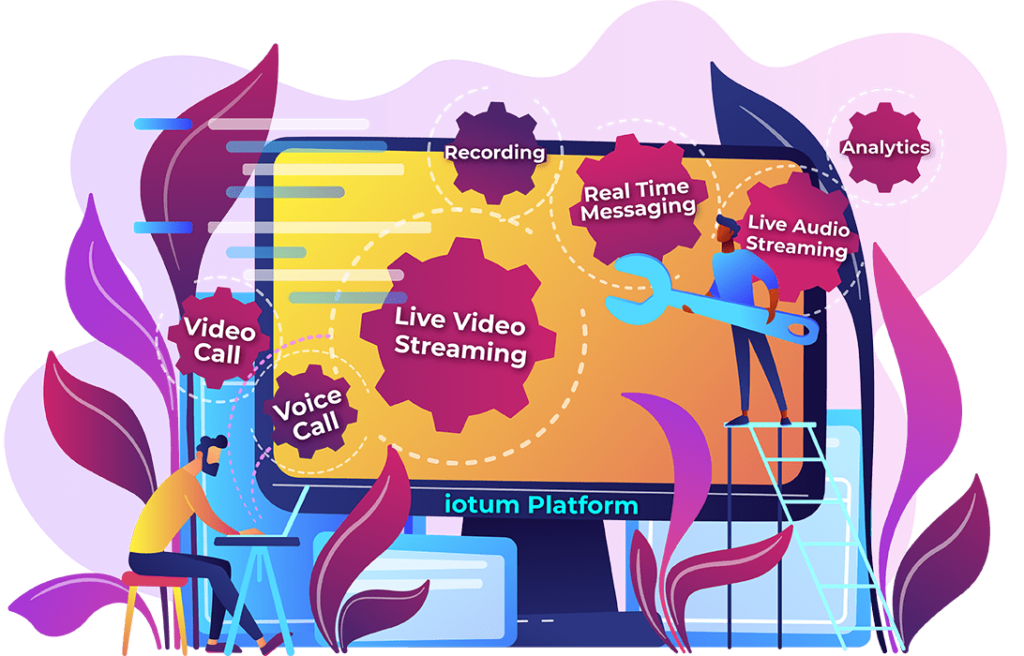 From inception to the finished product, every step of the way requires optimal team efficiency and team productivity for the best results. With a shift from in-person to online, however, how to improve your team performance starts by recognizing how teamwork affects every aspect of your organization within a virtual setting. Keeping in mind that the game changes when there is little to no face-to-face time or interactions with people in a physical setting, each team member’s strengths and weaknesses might be heightened or dimmed within the group.
From inception to the finished product, every step of the way requires optimal team efficiency and team productivity for the best results. With a shift from in-person to online, however, how to improve your team performance starts by recognizing how teamwork affects every aspect of your organization within a virtual setting. Keeping in mind that the game changes when there is little to no face-to-face time or interactions with people in a physical setting, each team member’s strengths and weaknesses might be heightened or dimmed within the group.
Not to worry though! There are plenty of strategies to improve team performance in a digital-centric space. In this blog post, we will cover:
- The little secret every manager needs to know
- The 2 types of KPIs
- How to be a better communicator
- Why a silent pause in conversation doesn’t have to be a bad thing
- … and more!
The first step to building a solid team that exudes collaboration and engagement for optimal performance is to hire well. Knowing what you need from future hires and being clear about expectations from current employees helps to create a picture in your mind’s eye about what needs to be brought to the table from each person. Outlining job requirements, having a thorough understanding of the specificities of a project, aligning with proper communication, and having a strong rapport with employees all work together to create vibrancy within the team.
Here’s a little secret: As the manager, everyone involved in any process needs to be aware of the expectations you have. How to improve team performance can be broken down into 4 different methods that empower collaboration, diffuse challenges, and spike productivity:
1. Set, Instill, And Live By Key Performance Indicators
If you can’t measure it, you can’t manage it, it’s as simple as that! If you don’t know where you’re at how can you know where you’re going? Most businesses are familiar with Key Performance Indicators (KPIs), a measure that quantifies and evaluates performance, the success of a business, or an activity. But more specifically, KPIs provide concrete reasoning and show you exactly if you hit your goal or not. They are especially conducive to pinpointing where, why, and how these goals were or weren’t achieved.
Organizational alignment is key. What makes a KPI effective is that everyone is made aware of what the measurement is before agreeing to it.
There are two types of KPIs:
- A quantitative KPI is measured in metrics. It deals in numbers and provides employees with a numbered objective to hit like acquiring XX clients per quarter.
- A qualitative KPI is descriptive and is more task-oriented like measuring through a video conference poll or survey to better understand the project’s demographic.
The top 10 KPI metrics include:
- Quantitative: Task Programs, workload efficiency, timesheet submittals, task dependencies, and project schedule
- Qualitative: Mentoring time, collaboration, stakeholder and client satisfaction, communication, and team evaluation
For KPIs to really ignite your team’s performance, ask yourself:
- Is your objective clear?
It should be really obvious what it is you’re trying to accomplish. Be as on point and specific as you can. The more laser-focused the end goal, the more measured and controlled your team’s performance will be. - Has it been shared with the team?
Know your audience. Refrain from fancy, confusing language. Get straight to the point and make sure everyone on your team has access to it. Communicate the KPIs in an online meeting, send them in an email, or include them in the handbook. It needs everyone’s eyeballs on it so all team members are on the same page and they can ask for clarification if needed. - When was it last updated?
Objectives and projects will ebb and flow. When a KPI changes, ensure everyone is on board. - Is it being spoken about?
Stay on track with frequent online meetings and briefings. Keep the door open for questions and answers while discussing the project’s trajectory. Let people know how they’re doing, how the project is faring and what’s being measured, and how.
2. Identify, Embrace And Combine Different Communication Styles
 Everyone has a personal style of communication. Understanding how you send messages and receive the messages of others is a powerful exercise in awareness. It can be used as a tool to drive more effective teamwork and communication in and outside an online meeting.
Everyone has a personal style of communication. Understanding how you send messages and receive the messages of others is a powerful exercise in awareness. It can be used as a tool to drive more effective teamwork and communication in and outside an online meeting.
Effective communication is essential for all relationships, including group dynamics. Learn how to be a proficient communicator in a group setting and watch your team’s performance vastly improve online, and in-person:
Here are a few ways to be a better communicator in a group setting:
- Listen to Understand…
…Rather than listening to reply. Sounds straightforward, but when we zone in and focus on what a colleague or manager is saying, it can make a difference between the information getting absorbed or not! Whether in person or via video conference, everyone responds better when they feel seen and heard. - Watch Body Language
Spoken language is important, but it’s what the body communicates that really pushes your message. How is the person you’re speaking to standing? Are their eyes sparkling or glossed over? Are their arms crossed or gesticulating? Take your body language into account too. Are you open or closed? Standing too close or not far enough? - Witness How Others Take Context Into Consideration
If you’re nervous about presenting a remote sales pitch, pay attention to how your team does it. Watch online videos of famous speakers and presenters. Note their body position and stance. Their vocal cadence and vocabulary. Take cues from the people around you so you can learn from the pros and appeal to your audience! - Silence Is Ok
Silence doesn’t have to be awkward. It’s natural and provides listeners with an opportunity to absorb the material and formulate a question or comment. Especially in groups where there is a mix of both slow and fast talkers, a moment of silence gives way to completion of thought so no one gets interrupted. - Avoid Literary Crutches
It’s natural to want to use the words “um,” “like,” and “er” as crutches to hold your spot while speaking or to help you drum up your next train of thought. Instead, speak more slowly and zone in on your breathing. - Throw In An Action Verb For Enhanced Language
For clearer more professional-sounding speech and communication, try leaning on strong action verbs like “spearheaded,” “amplified,” and “revitalized.” - Look For The Common Thread In An Argument
Even if you’re deep on a project in an online meeting with an unlikeable colleague, use the conversation as an invitation to figure out what it is you can agree on instead of disagree on. Searching for that common ground in a tense conversation or an argument can bring clarity and tighten up the team morale. If you have the same goal or end result, for example, shining a light on that might just be enough to course correct the conversation. - Choose “I Know” Instead Of “I Think”
Knowing what you’re talking about and presenting facts will position you as a strong team member others can rely on. Speaking in half-truths and making presumptions by saying, “I think it’s this…” or “I’m pretty sure it’s that…” doesn’t give you much authority or credibility. Instill trust and confidence by doing the research, speaking to the right people, and being certain in your claim so no one can dismantle it. - Implement Verbal Bridges
Sometimes conversations head towards a good old crash and burn. Redirect the route by finding a bridge to get back somewhere more agreeable. To shift the focus, use a “Yes, but…” “I’m curious to know more about…” “I invite you to consider…” “The important thing to remember…” This way, you can throw in a proverbial monkey wrench and re-steer the conversation in a more constructive way. - Know Where Your Story Is Going
Going on a tangent takes up time, and when you’re running a business, you don’t want to get lost in someone’s dilemma. Encourage people (and yourself) to be aware when telling a story. Are you telling a tale? Explaining a theory? Breaking down a concept? Before you start, know what the point of your share is and while you’re telling it, try to remove unnecessary emotion, too many details, and always have a destination in mind! - Take It Easy
Remember to breathe. Just relax, speak slowly and with intention! Your team is made up of people on the other side of the screen. As long as you’re courteous and professional, excellent communication will naturally follow.
3. Get Together To Work As One
 Even with a thorough understanding of key performance indicators and a heightened sense of dynamic conversation, managing a remote team might feel like there are many moving parts but at the end of the day, it’s still one team. Remembering that you are all working together as one breathes life into the collective being of your team.
Even with a thorough understanding of key performance indicators and a heightened sense of dynamic conversation, managing a remote team might feel like there are many moving parts but at the end of the day, it’s still one team. Remembering that you are all working together as one breathes life into the collective being of your team.
Ownership, peer-to-peer feedback, and frequent check-ins help to keep all the moving parts moving in sync. For example, constructive coaching and feedback that focuses on the behavior rather than the person promotes less defensiveness and better ownership. It sets an example of what to do without personally attacking anyone.
When team members realize that they don’t have to work in silos, and that people can rely on each other, the output of work increases. Not having to do everything on your own creates a dynamic flow. As long as everyone is clear on the hierarchy and roles of the project, the power of a team becomes exponentially stronger; Especially if team members are willing to mentor and onboard new talent.
With sophisticated features that come alongside video conferencing software to enhance connection like screen sharing, an online whiteboard and online meeting recordings, working as a cohesive unit is very possible online. Furthermore, integrations for Slack, Google Calendar and Outlook truly add to a seamless virtual connection in online meetings, project management, presentations, and more.
4. Encourage Additional Learning As A Team
Every employee brings their own unique skill set and experience to the team, but for each member to really shine and be successful in any role, it’s critical to build on this skill set individually, and as a group. Learning at work (and at the speed of technology!) is imperative for teams to adapt and perform alongside the competition.
So how are your employees learning? Online training, tutorials, video-based course material – the opportunities to sharpen skills and learn new ones are tremendous. Think about how new employees are onboarded, trained, and brought into the company; Or about how older, more loyal employees are provided the means to stay relevant and on top of new trends in technology and the marketplace.
A strong training strategy that develops your brand and gives purpose to employees will make your business appealing to new talent while strengthening the bonds of your team. On-the-job learning, mentoring, in-house training, individual study, pre-recorded material, and more can all be made available using video conferencing software. Live stream to YouTube or make videos accessible via an employee online portal.
By choosing Callbridge for your web conferencing needs, you can greatly affect how your team communicates in an online space. Vastly improve the way projects are handled, online meetings are conducted, and team dynamics are built upon. Use sophisticated features like Speaker Spotlight, Gallery View, and Screen Sharing to enrich your conversation and drive it forward toward improved team performance online.


